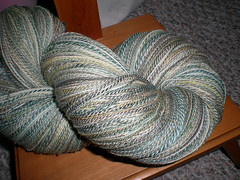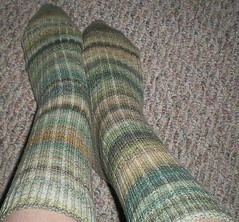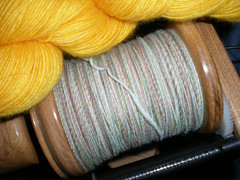 By Amelia © November 6, 2009
By Amelia © November 6, 2009"When do you set the twist?" comes up in almost every conversation I have with a new spinner. They're curious to know if they need to set the twist in the singles before plying, how to finish their skein once it's plied, or they want their skein of singles to relax and stop being so curly and twisty.
First, let me jump in with: you don't need to set the twist in your singles, or skein them up and wash them before plying. Just take them as they are, and ply them.
What we do as spinners, is not set the twist so much as either strive for balanced twist so the skein won't be curly and twist -- only possible with plied yarns -- or make the twist go dormant, so an over-plied or under-plied skein, or a skein of singles, seems relaxed and calm. (Secretly, however, it's not -- the twist is sleeping, waiting for a tap on the shoulder to wake it up.)
In fact, the moment you start winding yarn onto your spindle or wheel, you are stretching it out taut as you wind it on (right? right!). Winding the yarn under pressure like that will help the twist go dormant. Even after five minutes, the twist has started to get sleepy. After a weekend, it's snoozing; after a month, a moderate twist single is fairly comatose.
So, when you ply those dozy singles, you need a "live" sample to compare to, if your goal is balanced twist. Balanced twist is cool -- like an arch, the twist in the singles leans against the twist in the ply, each balancing the other out so your yarn appears calm and relaxed, behaves calm and relax, despite having all that twist stored in it. That is what makes yarn stronger than fiber -- the twist, holding the strands together, making the whole appear stronger than the sum of its parts (because we discount the 'invisible' force of the twist).
I usually ply a short length as I am first spinning my singles and save that sample to compare to when I ply. If I've forgotten, then I'll break off a length of singles, say 8", fold it in half, knot the ends together, and put it in a sink of warm water. It will writhe and twist on itself (very cool to see!). Once it's done with its water dance, I take it out, run my fingers along it so the twist is evenly distributed, and dry it in a towel. That sample shows how the singles can balance each other in the ply. If I match that when I'm plying, then I will have a balanced yarn.
Another way to test for balance, while plying, is to look at the fibers in the yarn. A balanced yarn has the fibers aligned along the length of the yarn. It takes strong eyes and good light -- and the right fibers -- to see the individual strands in the yarn.
Once you have plied your yarn, putting the skein in a warm bath will wake up any dormant twist and let you see if the skein is balanced or not. If the skein twists on itself more than 2 complete rotations, then it's underplied if it's twisting in the ply direction; or it's overplied, if it's twisting in the direction the singles were spun. If the skein is overplied or underplied, you can alter the amount of twist with another trip through on your spindle or wheel, adding whichever type of twist it needs (more ply twist or less ply twist).
All this warm bath is doing is waking up dormant twist. If you want to permanently alter the characteristics of your yarn, you have to look at methods that change it in irreversible, or hard to reverse, ways.
The primary method available to the handspinner is fulling -- have a sink of hot water and a sink of cold water, and a skein with plenty of figure eight ties on it. Agitate the skein in the hot sink for a few minutes; squeeze it out. Agitate the skein in the cold sink for a few minutes; squeeze it out. Keep going between sinks a few times -- you may see or feel the skein shrinking down as you do this. You are actually felting the yarn. Be careful, because extremely feltable fibers could become a yarn donut rather than a fulled skein -- test for strand separatability as you do this. You'll want to reskein the skein when you are done, carefully tugging apart any strands that have adhered (lightly, I hope!) to their neighbors.
Oh, and -- fulling only works with feltable fibers; superwash wool and cotton won't full, or not much anyway. I have managed to somewhat full superwash skeins such as the one at the top of the page -- an overplied sock yarn (socks below show no bias) Some wools are more feltable than others, as well. So if you plan to do this, try to felt some of the unspun fiber before committing yourself to the full project.
A milder fulling is to take your freshly washed (not agitated) skein, wrap it in a towel, and whack it really hard on a countertop or other hard surface. Do this a few times from both ends of the skein. This shocks the surface fibers and makes them grab onto the strands more. It helps develop a halo in fibers that do that -- yak, angora, mohair, for example.
Now, I won't do either of these more "shocking" things -- fulling or whacking -- until I've verified that my skein is either balanced, or has the amount of twist I want. I do overply my yarn on purpose -- it's a great way to add durability to sock yarns -- and then full the yarn so that it will knit into a straight fabric. I will shock my singles to get them to quiet down just a touch.
I typically only dry my skeins with weights if I intend to weave with them. That is because I need them to be inelastic to behave well as warp on my loom. But, I don't want to lose their elasticity with a permanent change -- the fabric, once removed from the loom, will be fulled, and in the process the yarn will wake up and regain its elasticity (which is then transformed in the fulling process).
If you wet-block a skein -- dry it with weights or while stretched out -- any active twist in the skein is still in it, dormant, similar to the old singles or yarn still on a spindle or bobbin. If you knit with the wet-blocked yarn and then wash the knit fabric, any twist dormant in the yarn will wake up and can cause the fabric or stitches to bias.
 How can you know if your fabric will bias? My usual test is to hold up my just-washed-and-squeezed-out skein. If the skein twists on itself more than two complete rotations, then the fabric is likely to bias. If it's less than two full rotations, I might see some biasing in the stitches -- one leg upright, the other at an angle, on the knit-face of the fabric -- but I won't see any in the fabric. There are knitting methods you can use to overcome bias, as well -- garter stitch and seed stitch are less likely to bias. My crochet friend tells me she doesn't see any biasing in her crocheted fabric, often made with her own handspun, moderately high twist singles.
How can you know if your fabric will bias? My usual test is to hold up my just-washed-and-squeezed-out skein. If the skein twists on itself more than two complete rotations, then the fabric is likely to bias. If it's less than two full rotations, I might see some biasing in the stitches -- one leg upright, the other at an angle, on the knit-face of the fabric -- but I won't see any in the fabric. There are knitting methods you can use to overcome bias, as well -- garter stitch and seed stitch are less likely to bias. My crochet friend tells me she doesn't see any biasing in her crocheted fabric, often made with her own handspun, moderately high twist singles. Other finishing techniques include steaming a stretched-out skein, simmering a skein (often done with cotton), and, I suppose, ironing a skein -- though I haven't tried that one. Commercial mills have much higher temperatures and more specialized equipment than the home spinner, I am curious to know how they create the calm singles that are Malabrigo laceweight, for example -- if you try a warm-water folded-back length of that yarn, it barely twists on itself at all. But the fibers are not aligned. I've tried fulling, and kettle steaming, but so far have not managed to produce a similar skein of yarn despite copying fiber and twist amount. The trick is in the finishing -- so there's yet another way to finish a yarn that I have not yet uncovered.
Other finishing techniques include steaming a stretched-out skein, simmering a skein (often done with cotton), and, I suppose, ironing a skein -- though I haven't tried that one. Commercial mills have much higher temperatures and more specialized equipment than the home spinner, I am curious to know how they create the calm singles that are Malabrigo laceweight, for example -- if you try a warm-water folded-back length of that yarn, it barely twists on itself at all. But the fibers are not aligned. I've tried fulling, and kettle steaming, but so far have not managed to produce a similar skein of yarn despite copying fiber and twist amount. The trick is in the finishing -- so there's yet another way to finish a yarn that I have not yet uncovered.~~
The Bellwether is having holiday sale -- 15% off select items through the end of 2009. Shop early for the best selection, and thanks! for supporting Ask The Bellwether!
~~
Related posts on finishing yarn:
How do you set the twist in handspun cotton?
What makes my handspun yarn bloom?
How do you steam block handspun yarn?
What do I do with my very first full spindle?
Do you set the twist in handspun singles before you ply?
How do I ply set singles?
Is my yarn's twist set when I ply it?
Why do you wash the finished skein in warm or hot water?
How do you set the twist in singles yarn?
~~
© 6 November 2009 by Ask The Bellwether, posted at http://askthebellwether.blogspot.com/
